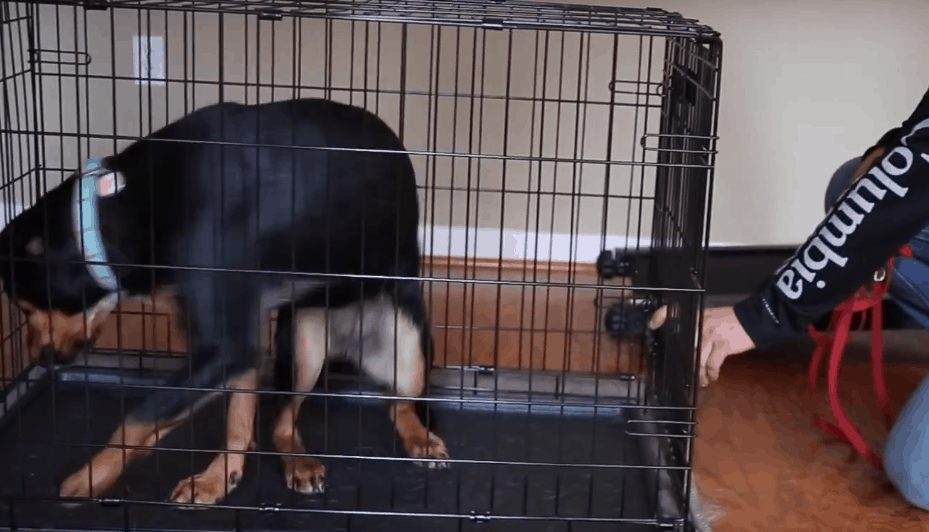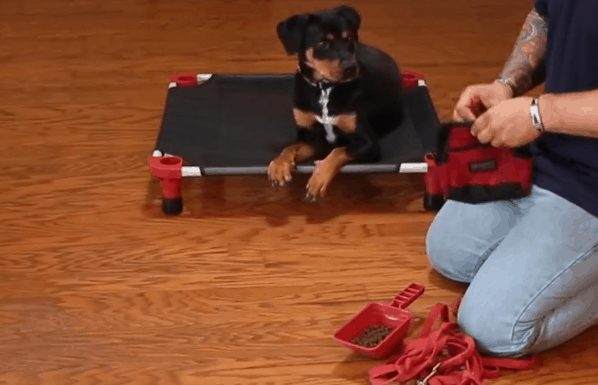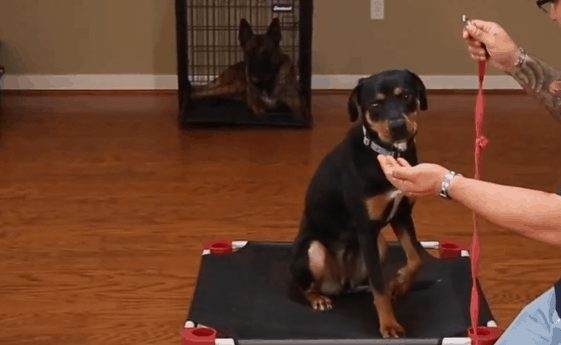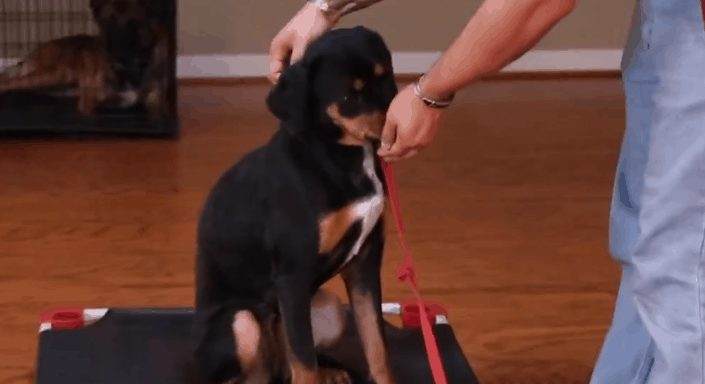When it comes to adding confidence to your dog, you can use methods like take walks with the dog, making other dog friends to your dog, spend time with the dog so that he trusts you, play games with the dog and use desensitizing. All of these are explained in more detail in this article.
Dogs are no different to humans in regards to exhibiting varying personalities. With dogs, just as with humans, these personalities could be inborn, or they could be acquired through life experiences. You will come across dogs that are playful and energetic while others are timid and fearful.
It is common for humans to assume that every dog is easygoing, but this assumption is far from reality. The world is not short of shy and fearful dogs that get frightened by all kinds of triggers. Although all animals experience fear, such dogs exhibit elevated levels of fear and anxiety.
The most common of such triggers are strangers and other dogs. But such fearful canine behavior is not set in stone. With some help, fearful dogs can gain confidence and thereby lead to much better lives.
When my dog started training, he had a few problems with fearfulness. Every time I went to reach for the collar, he backed down a little bit which is known as fearfulness or shyness.
The dog honestly doesn’t know what’s happening. What we’re trying to do is help him overcome that sudden emotion of shyness.
Also in the process, we want to help him understand that grabbing the collar is not a big deal. The best way to do that it to give him some sort of motivation to pair that up with that sensation.

Why the dog is scared of everything?
- Dogs may become timid and fearful as a result of trauma at a young age. Such trauma could have resulted from abuse or accidents.
- Genetic predisposition could also make some dogs to experience elevated levels of fear and anxiety.
- In many cases, dogs exhibit fear due to a lack of experience with the trigger factors.
- Aging dogs are prone to anxiety. Pets with medical problems such as chronic pain, diminished eyesight, and mobility issues can also exhibit fear and anxiety.
- During their developmental period, puppies begin to be aware of their surroundings. They show curiosity and caution as they try to figure out new phenomena in their world. With time, many of them overcome their fear of the unknown and proceed to explore their environment confidently. Some of the puppies, however, never overcome this fear. They develop to be timid and fearful of people, objects and other dogs.
How to tell whether your dog is fearful
A fearful dog’s coping strategy is to avoid the triggers of his fear. Sometimes dogs are unable to avoid what frightens them.
Fearful dogs may show the following behaviors when they come in contact with the source of their fear.
- Flatten their ears back to the head.
- Crouch down in fear.
- Shy away from interacting with humans and other dogs.
- Tuck their tails between their legs.
- Their eyes become dilated and glassy.
- Hide or pace away.
- Whining, barking, sneering or biting.
- Raise their hackles and urinate submissively.
- Refuse to make eye contact.
While many shy dogs show shyness toward both people and dogs, some of them are only shy toward people, while others are only shy toward other dogs.
Other trigger factors could affect fearful dogs including vehicles, thunder, and new phenomena.
If your dog exhibits fear or anxiety, you should never force them to interact with the trigger. If, for example, your dog barks at your neighbor’s dog, that is not the time to try and have the two dogs bond.
Barking and growling is your dog’s way of telling you that they’re triggered, and they can even be aggressive if pushed.
Your dog may also be experiencing anxiety if it is drooling and panting heavily. Sweating paws and destructive chewing are also symptoms of dog anxiety. Shadow chasing I an anxiety symptom as well.
There are Many Possible Phobias
Pet owners, when they realize that their dogs have phobias, tend to address this by comforting them. The dogs interpret such a response from the owners as a reward, which can reinforce the fearful response. The aim should be to remove the fearful response.
You do this by showing your pooch that what triggers their phobias is not perilous. There are multiple methods to do this, many of which involving exposing your dog to the trigger safely and gradually. Forcing your dog to interact with the cause of their fear will only worsen the situation.
You should never push your pet. Instead, train them safely and gradually until they realize that they are not in danger interacting with the trigger factor. Ignoring the fearfulness may also be a good strategy for addressing such phobias.
Such dogs should undergo distress management just as humans do when they face similar problems.
Systematic desensitization is a type of behavioral treatment that is very effective for dogs with post-traumatic stress disorder. The therapy involves safely and gradually exposing the dog to its fear. This is done in small doses.
Dogs suffering from PTSD are guided through daily exercises and training to help them deal with their condition. Treatment may take several weeks, but it is worthwhile as it improves the life of the dogs as well as the pet owners.
How to build confidence in an insecure dog?
Positive association is perhaps the most effective way to teach dogs new things. Fearful dogs can be helped to overcome their fear by exposing them to the trigger factors at a low intensity, all while pairing the exposure with a bridge, such as dog treats.
This process is known as counter conditioning and desensitization. If the process is done successfully, it can be very beneficial to your dog as it can help them be more comfortable in their environment.
1. Initially, Short Walks are Good
Fearful dogs might not be excited about taking a walk as most dogs would. Shy dogs do not like to leave the environment they are familiar with because of the fear of the unknown. You should never force your pooch to take a walk.
Fearful dogs can quickly learn to associate certain cues with fear and anxiety. If your pooch learns this association, it can be very hard to unlearn.
That is why it is crucial that you be gentle to your dog while introducing them to taking walks.
Don’t push them to take walks if they are opposed to it. Start by taking small walks around your home as an introduction. Walk-in calm areas where it is unlikely for your dog to come across things that make her nervous.
2. Other Dogs can Cause Issues
Don’t let other dogs interact with your fearful pup in public settings. Many pet owners will want their dogs to play with other dogs, but such an experience can be traumatizing for your pooch. Avoid interaction with other dogs until your dog has attained a significant level of confidence.
Fearful dogs can be very uncomfortable around other dogs, even when the other dogs mean well. Once your pup has made progress, you may ask a friend to bring their pup over so that the dogs can play.
This can help them become more confident around other dogs. Let the play dates happen in your compound so that your dog can feel in control of the situation.
3. Make and Stick to a Daily Routine
Establishing a daily routine makes the environment more predictable for your dog. Predictability allows dogs to form structure and gain stability in their behavior.
A daily routine will help your dog gain confidence in the activities it engages in. Predictability creates a sense of safety, and the environment ceases to be a mystery.
It is important to ensure that you adopt a realistic routine – that is a routine that you will be able to follow as planned. You may do this by incorporating your dog in your already established routine.
This would involve such things as serving your pup’s meal when you are serving your own meal, and having playtime daily immediately after you get home from work.
Your pooch may take a couple of weeks to get used to the routine. Eventually, they will be more confident in their activities.
4. Adding Training is a Must Have
Training can help your pup to gain confidence. Begin with some basic training such as sitting and staying exercises, and then proceed to more advanced exercises.
Training can help in establishing trust and understanding between the pet owner and the pet. Through training, your dog learns that you are fair and trustworthy.
Ensure that the training process is as fun as possible for your dog. make friendly eye contact with our pooch.
Talk and smile at him. Use different kinds of treats such as food and toys to reward him for good behavior. The treats motivate your dog to perform better in training.
Other than obedience training, it would be great if you took your pooch through some tricks training. Skills such as spinning in a circle and dancing while standing will help your pooch to gain confidence around people and other dogs.
Training helps your pup understand you better which is essential especially for timid dogs. Training your dog will also be an excellent chance to improve your control and communication skills which can help in improving the relationship between yourself and your dog.
This book has good information and you should purchase and read it once for sure.
5. Making Your Dog Comfortable: What You Need
I’m going to show you how I helped my dog out to become very comfortable with anybody grabbing the collar. In order to get started, you’re just gonna need 3 things:
- A little bit of your dog’s food.
- A long lead, at least 10 feet.
- Treat pouch, big enough for you to put your hand in without having to look down and of course, your dog.

Make sure he knows what the place command means. You always want to start by putting the food in the treat pouch in front of your dog’s view.
This helps him get excited about training because to him food equals fun. I want your dog to see the food and get excited and ready to start. At this time, you’ll start the process of putting the leash on him.
6. Training a Fearful Dog to Walk on a Leash?
First, you give him the food, show him the leash, take a step back and wait for him to show interest again. The second time, you will approach again and you’ll give him food and grab on to the collar, tug a little bit and step back again.
The third time, you’ll show him the food first so he focuses just on the food. At the same time, you will hold onto the collar, move it a little bit and clip on the leash.
Do make sure that his level of stress is low but the level of his interest is still high. You first start using the leash, especially the long line because if he tries to run away you’ll help him, bring back to you.
Adding leash is important because a leash makes him comfortable with you. He’s already in that fearful state of mind. You don’t want to reinforce the thought in his mind that the only time you touch the collar is when you’re giving him food.
Now that the dog is learning to get used to you grabbing the collar, it’s time for the main part of the exercise drill.

7. How to get a scared dog to trust you?
It is best to always start slow. The best way is to walk to the dog, stand up in front of them. Then slowly grab the collar and give them the food tugging at the collar just a tad bit and then stepping away.
As the dog gets more comfortable, try touching and stepping back a little faster each time. Also, increase the time that you’re touching the collar just by a few seconds.
The only thing to make sure in this game is that after touching the collar, step back for a few moments before trying again.
Once you’re done giving them the food and pulling on the collar you stop and step away. The reason for that is because you want the dog to learn that the moment you give them the pressure and they start eating food, the pressure will go away.
The real reason dogs run away or don’t want you to touch their collar is because they don’t want to feel the touch anymore. They’re looking for an out. By doing the above, you’re still giving them that out that they want.
But what you’re doing with the food is creating a different experience for them. And as you’re creating a different experience, you’ll start increasing the time of your touch.
Also, you’ll increase the movement of the collar and also the difficulty level.

8. Dog confidence building exercises
Increasing the level of difficulty of the exercise means that you only change one little thing. You either make the movement a lot faster, become a little more playful when you’re touching the dog.
Or just spend a little extra time touching each time. Or if you’re like me, add little extra sound effects to the game.
The key is to be creative. Come up with different ways that you can move your hands, move your body, touch their legs, their backside, just his whole body.
In the process, you also help him understand that it’s not a big deal for you to touch him. But it’s also not ok to squirm or run away. That little technique itself is gonna help him overcome that fearfulness.

You want your dog to get used to more than a person touching them. So, you can take the help of other people and they are going to do the same thing. Just a little bit of touching, a little bit of movement.
Get your dog used to being touched by other people, other situations. As you and your help increase the touch, movement and time, their level of fear or uncertainty to other people will decrease as well.
What I do is, I want to catch my dog a little bit off guard. Catching him off guard is getting him used to somebody just grabbing the collar or touching him without becoming startled.
Every time I grab the collar and he gives me a good response then I give him the food and we try back and forth.
9. Canine Helpers
Canine helpers are confident, well-trained dogs that help fearful dogs to gain confidence. The canine helpers are very confident when playing and taking instructions.
Your dog can observe the canine helper having fun and may want to join in on the fun. Your dog must first trust the canine helper to be comfortable around them.
Try to stay close to your dog as she tries to interact with the canine helper for emotional support.
10. Fun Games
Fearful dogs tend to stay away from games. You can break the cycle by teaching your dog to play various games that will make them relax and have a great time. Three play sessions per day would go a long way in making your dog happier and less fearful.
Start with playing on familiar grounds only and then advance to playing in unfamiliar grounds as she gains confidence.
Fearful dogs have a “worry radius” at which they are unbothered as long as no one or nothing is within the radius. Try to reduce this radius slowly and gradually. After some time, this radius can cease to exist.
11. Desensitizing
Desensitizing is a process that involves associating a good experience with a bad one. You do this by introducing the trigger and then follow through with a treat. Your dog will then learn to associate the trigger with a treat and thereby cease to be terrified of the trigger.
The trigger should be introduced gradually, and you shouldn’t reward your pooch when she reacts poorly to the trigger. With time, your pup will be looking forward to the signal (formerly a trigger) because she knows that a treat will follow.
12. Make nervous dog more confident by adding distractions like scents
You can distract your timid dog from her fear by training her to find scented items that you hide in the house. You can start the training by placing a treat somewhere that she can easily find and then give her verbal praise when she finds it.
If she starts having fun with the task, you can then hide various scented items in places that are harder to find. Give her different kinds of treats when she succeeds in finding them. Such activities are beneficial in building a fearful dog’s confidence.
13. Teaching Tricks and Using Treat
Train your dog a few tricks and always give her a treat when she succeeds in pulling off the trick. Engaging in tricks keeps her distracted from her worries. Start with activities that are simple to master. Tricks such as shaking, spinning and rolling over can boost your dog’s confidence.
14. Never Think of Punishing Fearful Dog’s Mistakes
Many pet owners tend to get frustrated by the demeanor of their timid dogs and punish them for it. This should never happen. Punishments such as yelling at or hitting the dog could make your dog’s situation worse and will not solve the problem.
Dogs that exhibit fear need to be assured that they are safe in your presence. Punishing them for their uncontrollable fear only makes them feel even more unsafe.
15. Never Give Up on your Dog
Conquering fear takes a lot of time and effort, and you may sometimes feel as if the process is too much for you. You should, however, be patient with your dog and let them know that they are safe. Teach them to trust you and help them overcome their fear as much as you can.
Learn More With the Help of Videos
Situations to avoid with your fearful dog
- Tethering him near places where he could come in contact with trigger factors, such as near restaurants or pathways.
- Forcing your dog to confront their fear.
- Trying to have your dog make eye contact or other forms of contact with strangers.
- Having too much disturbance in your home such that your dog can hear loud noises.
- Very intense training.
- Forcing your dog from her hiding places. You should wait for her to come out freely.
- Going with your dog to chaotic places where there is little order. You should only take her to calm places until her situation improves.
You Could be Adding Up Fear To Your Dog?
It is fairly common for pet owners to send messages that confuse their dogs. Dog owners sometimes give their dogs way too much control such that their dogs feel in charge. Such dogs feel that they have the responsibility of keeping your family safe which could be terrifying and confusing for them.
When some dogs think that they are the pack leader, they get stressed due to the pressure of making decisions. Fortunately, dogs can be helped through overcoming their fear and anxiety, no matter what causes such timid behavior.
You may ask yourself the following questions when trying to figure out where your dogs fear and anxiety originates from
- Are there any changes that have occurred in your dog’s environment?
- Have there been people who have moved out of or moved into the house?
- Have there been any significant changes to the house schedule?
- Is anyone in your home who is experiencing anger or anxiety?
- Have there been any significant disturbances in your home?
Conclusion on how to raise a confident dog
After doing the above, you will notice a sudden decrease in jerking movements that you saw before.
You’ll know that the state of mind that he had when somebody went to reach for him, is not there anymore. Now that it’s not there, you can start doing other types of training.
The key is to allow a dog to understand that it’s not a bad thing to feel something in the collar. We want to help him overcome that challenge of touching the collar. After that, we can bring more challenges.
The more challenges that we bring to the dog, the more obedient he’ll become. This will eventually result in a better lifestyle that he’ll have in the long run.
As regarding the weather and thunder when dogs get fearful, do read our article on how to handle your dog’s confidence during thunder and make him comfortable.
Removing fear from the dog is not impossible. It does take a little bit of practice. A little bit of time. But if you’re diligent and you’re loving enough, your dog will not only transform himself into a better dog but into a more obedient dog.
References
- https://veterinaryrecord.bmj.com/content/152/14/432.short
- https://www.naturalpethealthfoods.com/1/category/aggression/1.html
Table of Contents